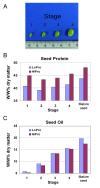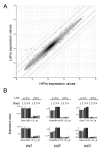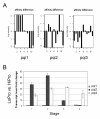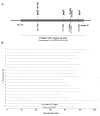Complementary genetic and genomic approaches help characterize the linkage group I seed protein QTL in soybean
- PMID: 20199683
- PMCID: PMC2848761
- DOI: 10.1186/1471-2229-10-41
Complementary genetic and genomic approaches help characterize the linkage group I seed protein QTL in soybean
Abstract
Background: The nutritional and economic value of many crops is effectively a function of seed protein and oil content. Insight into the genetic and molecular control mechanisms involved in the deposition of these constituents in the developing seed is needed to guide crop improvement. A quantitative trait locus (QTL) on Linkage Group I (LG I) of soybean (Glycine max (L.) Merrill) has a striking effect on seed protein content.
Results: A soybean near-isogenic line (NIL) pair contrasting in seed protein and differing in an introgressed genomic segment containing the LG I protein QTL was used as a resource to demarcate the QTL region and to study variation in transcript abundance in developing seed. The LG I QTL region was delineated to less than 8.4 Mbp of genomic sequence on chromosome 20. Using Affymetrix Soy GeneChip and high-throughput Illumina whole transcriptome sequencing platforms, 13 genes displaying significant seed transcript accumulation differences between NILs were identified that mapped to the 8.4 Mbp LG I protein QTL region.
Conclusions: This study identifies gene candidates at the LG I protein QTL for potential involvement in the regulation of protein content in the soybean seed. The results demonstrate the power of complementary approaches to characterize contrasting NILs and provide genome-wide transcriptome insight towards understanding seed biology and the soybean genome.
Figures







Similar articles
-
Dissecting the Genetic Architecture of Seed Protein and Oil Content in Soybean from the Yangtze and Huaihe River Valleys Using Multi-Locus Genome-Wide Association Studies.Int J Mol Sci. 2019 Jun 21;20(12):3041. doi: 10.3390/ijms20123041. Int J Mol Sci. 2019. PMID: 31234445 Free PMC article.
-
Mapping and validation of simple sequence repeat markers linked to a major gene controlling seed cadmium accumulation in soybean [Glycine max (L.) Merr].Theor Appl Genet. 2010 Jul;121(2):283-94. doi: 10.1007/s00122-010-1309-6. Epub 2010 Mar 12. Theor Appl Genet. 2010. PMID: 20224890
-
Dissecting genomic hotspots underlying seed protein, oil, and sucrose content in an interspecific mapping population of soybean using high-density linkage mapping.Plant Biotechnol J. 2018 Nov;16(11):1939-1953. doi: 10.1111/pbi.12929. Epub 2018 May 16. Plant Biotechnol J. 2018. PMID: 29618164 Free PMC article.
-
Molecular mapping and genomics of soybean seed protein: a review and perspective for the future.Theor Appl Genet. 2017 Oct;130(10):1975-1991. doi: 10.1007/s00122-017-2955-8. Epub 2017 Aug 11. Theor Appl Genet. 2017. PMID: 28801731 Free PMC article. Review.
-
Harnessing Artificial Intelligence and Machine Learning for Identifying Quantitative Trait Loci (QTL) Associated with Seed Quality Traits in Crops.Plants (Basel). 2025 Jun 5;14(11):1727. doi: 10.3390/plants14111727. Plants (Basel). 2025. PMID: 40508402 Free PMC article. Review.
Cited by
-
Relationship between asparagine metabolism and protein concentration in soybean seed.J Exp Bot. 2012 May;63(8):3173-84. doi: 10.1093/jxb/ers039. Epub 2012 Feb 22. J Exp Bot. 2012. PMID: 22357599 Free PMC article.
-
A near-isogenic line (NIL) collection in diploid strawberry and its use in the genetic analysis of morphologic, phenotypic and nutritional characters.Theor Appl Genet. 2015 Jul;128(7):1261-75. doi: 10.1007/s00122-015-2503-3. Epub 2015 Apr 5. Theor Appl Genet. 2015. PMID: 25841354
-
Development of sequence-based markers for seed protein content in pigeonpea.Mol Genet Genomics. 2019 Feb;294(1):57-68. doi: 10.1007/s00438-018-1484-8. Epub 2018 Sep 1. Mol Genet Genomics. 2019. PMID: 30173295
-
Identification of Gene-Allele System Conferring Alkali-Tolerance at Seedling Stage in Northeast China Soybean Germplasm.Int J Mol Sci. 2024 Mar 4;25(5):2963. doi: 10.3390/ijms25052963. Int J Mol Sci. 2024. PMID: 38474209 Free PMC article.
-
Detecting SNPs underlying domestication-related traits in soybean.BMC Plant Biol. 2014 Sep 26;14:251. doi: 10.1186/s12870-014-0251-1. BMC Plant Biol. 2014. PMID: 25258093 Free PMC article.
References
-
- Hajduch M, Ganapathy A, Stein JW, Thelen JJ. A systematic proteomic study of seed filling in soybean. Establishment of high-resolution two-dimensional reference maps, expression profiles, and an interactive proteome database. Plant Physiol. 2005;137(4):1397–1419. doi: 10.1104/pp.104.056614. - DOI - PMC - PubMed
-
- Gallardo K, Firnhaber C, Zuber H, Hericher D, Belghazi M, Henry C, Kuster H, Thompson R. A combined proteome and transcriptome analysis of developing Medicago truncatula seeds: evidence for metabolic specialization of maternal and filial tissues. Mol Cell Proteomics. 2007;6(12):2165–2179. doi: 10.1074/mcp.M700171-MCP200. - DOI - PubMed
-
- Jukanti AK, Heidlebaugh NM, Parrott DL, Fisher IA, McInnerney K, Fischer AM. Comparative transcriptome profiling of near-isogenic barley (Hordeum vulgare) lines differing in the allelic state of a major grain protein content locus identifies genes with possible roles in leaf senescence and nitrogen reallocation. New Phytol. 2008;177:333–349. - PubMed
Publication types
MeSH terms
Substances
LinkOut - more resources
Full Text Sources
Other Literature Sources
Molecular Biology Databases
Miscellaneous

